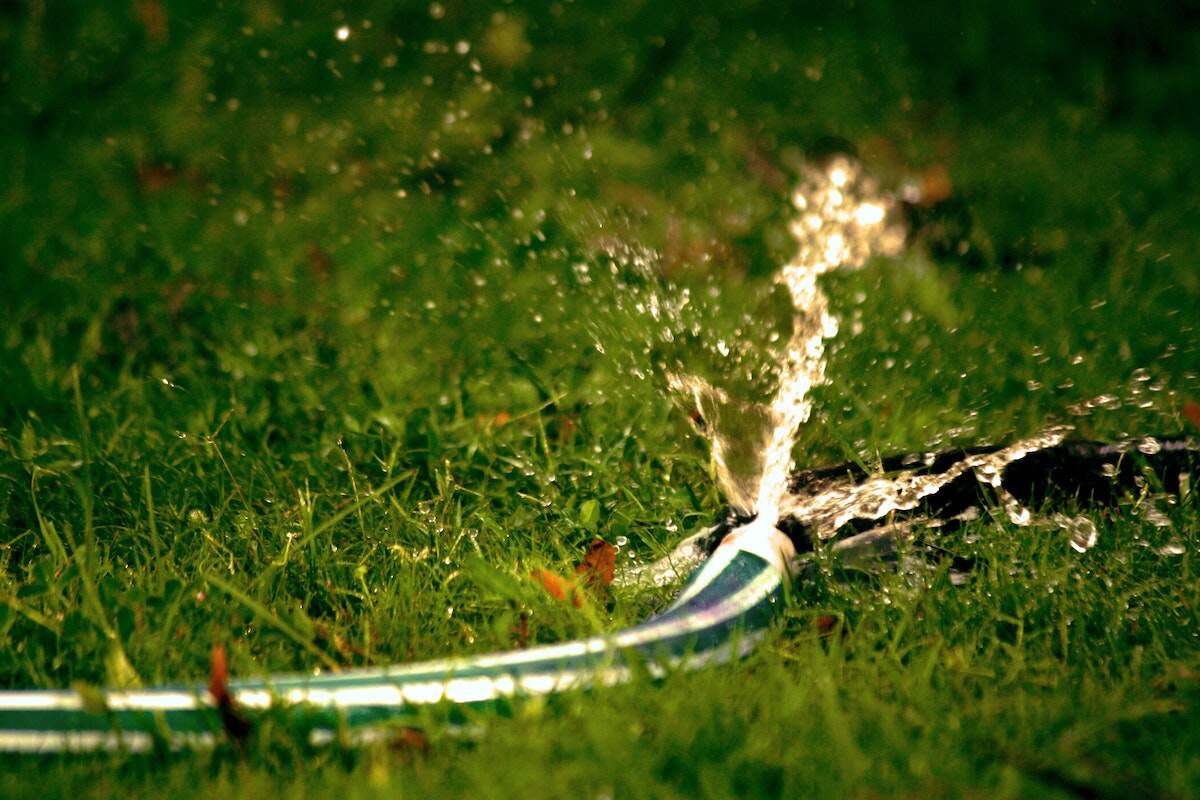
You know when a Florida lawn is watered correctly. The grass is thick, dense, green, and sturdy. Most Floridians follow the rule of thumb: water 1 to 1.5 inches per week in one or two watering sessions. But grass needs vary across the Alligator State with soil, time of year, and shade. Standard irrigation can fail. Use these lawn watering tips for the Florida climate to irrigate your grass precisely as it needs for healthy growth.
- 1. Be Aware of Florida Water Restrictions
- 2. Water Early in the Morning
- 3. Pay Attention to Your Florida Lawn Needs
- 4. Reduce Irrigation During Winter
- 5. “Can-Test” the Sprinkler System
- 6. Make Your Irrigation System Smarter
- 7. Consider High-Efficiency Sprinkler Nozzles
- 8. Harvest Rainwater
- 9. Choose the Right Type of Grass for Your Florida Lawn
- 10. Mow the Grass Taller
- 11. Aerate and Dethatch the Lawn
- FAQ
Let’s discuss each tip and see how you can use it to improve your lawn’s health and your watering routine.
1. Be Aware of Florida Water Restrictions
It makes no sense to pay a fine for watering at the wrong time when you can easily avoid it. Find out precisely when you are allowed to irrigate your lawn to avoid penalties.
Florida has five Water Managements Districts that manage and protect the state’s water resources, ensuring there is enough water for everyone during dry spells. Generally, homeowners are allowed to irrigate the landscape up to two times a week, in the late afternoon, evening, and early morning. But water restrictions vary by district, county, and city.
You can consult your district’s rules using the links below:
- St. Johns River Water Management District
- Southwest Florida Water Management District
- South Florida Water Management District
- Suwannee River Water Management District
- Northwest Florida Water Management District
County and city-level restrictions prevail if they are more severe than district regulations.
2. Water Early in the Morning
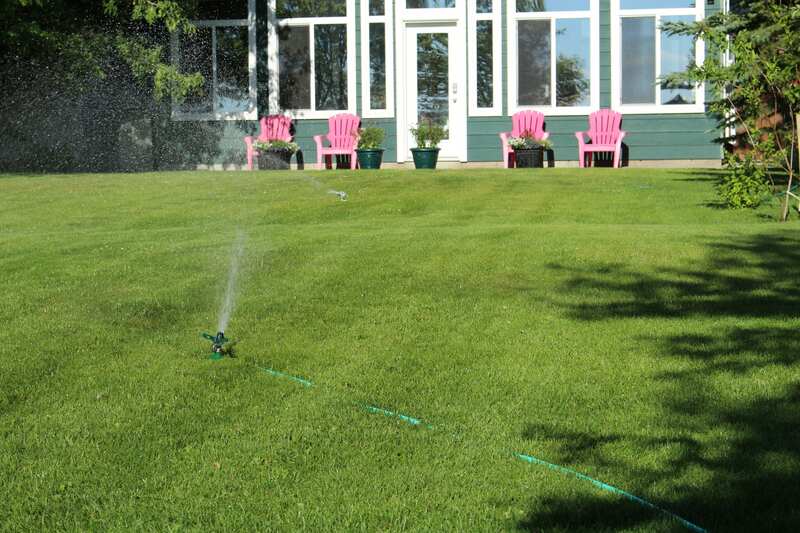
The best time of day to water your lawn in Florida is the early morning hours, 5:00 – 7:00 a.m. It’s when the air is still cool, and the sun is barely up. You’ll lose less water through evaporation, and the soft morning sun evaporates any drops on the blades. You can stretch it until 8:00 to 10:00 a.m. (depending on local restrictions) if you’re a night owl, but no later than that.
The second option is late afternoon and evening (typically after 4:00 p.m. according to state restrictions). But (and there is a big BUT) evening irrigation exposes the grass to fungal diseases since the water stays for hours on the blades. Don’t make this a regular watering schedule.
Watering in the middle of the day is the worst watering time and a huge waste since about 40 to 60% evaporates under the afternoon heat. Water drops also function as tiny (but effective) lenses on the grass blades, focusing sunlight and causing burn spots.
3. Pay Attention to Your Florida Lawn Needs
Myakka soil (the official state soil) is mainly sandy, with low water retention. It holds about 1 inch of water in the top 12 inches of soil (the root zone). But Florida soils are not the same all over the state. For example:
- Miami-Dade County soil is more rocky and loamy.
- Cutler Bay soil is mucky.
- Tampa, St. Petersburg, and Orlando have sandy soils.
- The ground is richer in clay in the Panhandle area (Pensacola, Tallahassee, Jacksonville).
The soil’s ability to absorb and hold water also changes with the amendments each owner makes. Your best bet for an effective and healthy watering routine is to pay attention to the soil and plants in your yard.
Water only when 30 to 50% of the turfgrass shows signs of drought, such as:
- Grass blades fold in half.
- Grass turns a bluish-grey color.
- When you step on the lawn, traces of your feet remain imprinted longer than usual.
Apply ½ to ¾ inches of water per session. Irrigate once or twice a week on an “as-needed” basis.
Water thoroughly. This encourages deep, robust roots with better resistance to drought, fungi, and pests than grasses with a shallow root system.
Pro tips for deciding when to turn the sprinkler system on in Florida:
- Use a rain gauge to find out how much water the last rain brought to your lawn.
- Avoid watering if it rained in the last 24 hours or the forecast says it will rain in the next 48 hours.
4. Reduce Irrigation During Winter
In Northern and Central Florida, warm-season grasses go dormant during winter, while in the south they mostly just slow their growth. Whether fully dormant or just slowing down, turfgrasses still need watering but less than during their growing season.
Set the irrigation system to water once a week if it doesn’t rain, and no more. Overwatering during winter exposes the lawn to common Florida pests and fungal diseases such as brown patch.
Learn more with our tips for winter lawn care in Florida.
5. “Can-Test” the Sprinkler System
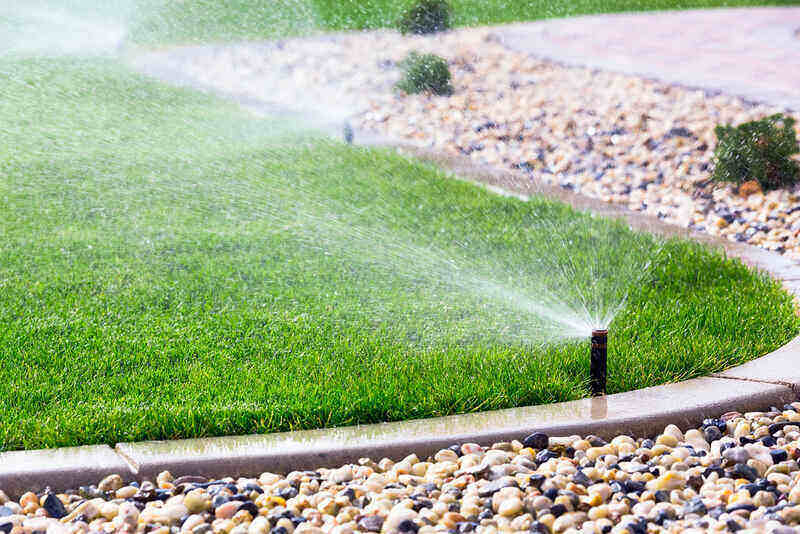
Use the “can test” to ensure your sprinklers apply the right amount of water and that it spreads uniformly throughout the lawn. Here’s how:
- Place a few empty tuna cans or measuring cups around the yard.
- Spread them to cover all irrigation zones.
- Turn the irrigation system on for 15 minutes.
- Stop the sprinkler system. Take one cup and measure the liquid.
- Calculate how long the sprinklers need to spread ½ or ¾ inches of water.
For example, if your cans have 1/4 inch of water after 15 minutes of watering, you’ll need to keep the sprinklers on for 45 minutes to apply ¾ inches.
Don’t stop there. Measure the quantity in each cup to ensure the sprinklers spread water uniformly. If you find cups with less or more water than the others:
- Check sprinkler heads for damage or clogging.
- Rotate or move sprinklers to cover the lawn better. Go for head-to-head spacing, in which each sprinkler’s radius reaches the nearest sprinkler head – see the image below).
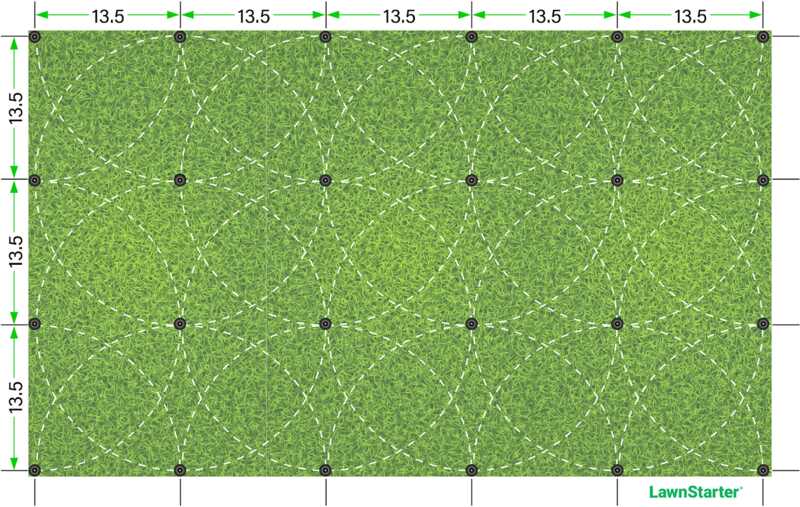
6. Make Your Irrigation System Smarter
The ideal scenario is you checking the lawn every evening and setting the sprinklers for the next morning if the grass is dry. But, with a busy life, it’s often easier to rely on a controller for watering the grass at the right time. Make sure your automatic irrigation system is smart enough to make the right decisions for your lawn. Here’s how:
Install a Rain Shut-Off Device
Also named rain sensor, this add-on is required by Florida Law (Section 373.62 F.S.). Rain sensors stop the irrigation system from turning on when it rains and for a time after that. They do an excellent job of preventing overwatering and lowering water bills during summer.
Use Soil Moisture Sensors (SMS)
More effective than rain sensors, soil moisture sensors tell you how wet the soil is. They take into account the soil’s ability to capture water, which is invaluable for grass root health. New models can be connected with a Wi-Fi controller to the irrigation system.
Consider an Evapotranspiration (ET) Controller
These are also called smart controllers, and they can save 30 to 40% of water during dry periods and 70 to 90% during normal Florida rainfall. ET controllers take into account water evaporation from the soil, temperature, and water transpired by the turfgrass to estimate when your lawn needs water. Pretty amazing, isn’t it?
Try an Irrigation App
The Smartirrigation Turf app, developed by the University of Florida, can help lawn owners manage irrigation. It uses real-time data about rainfall in your area.
Pro tips for adding sensors to sprinkler systems in Florida:
- Choose sensors that use local data, collected from your yard. They are more accurate than models that use data collected from weather stations around your location.
- Register for rebates. Most counties have a rebate program for installing such devices. An expert comes, checks your lawn, and makes a report with suggested improvements to save water. You choose the changes you are willing to make and can benefit from up to a $500 rebate.
7. Consider High-Efficiency Sprinkler Nozzles
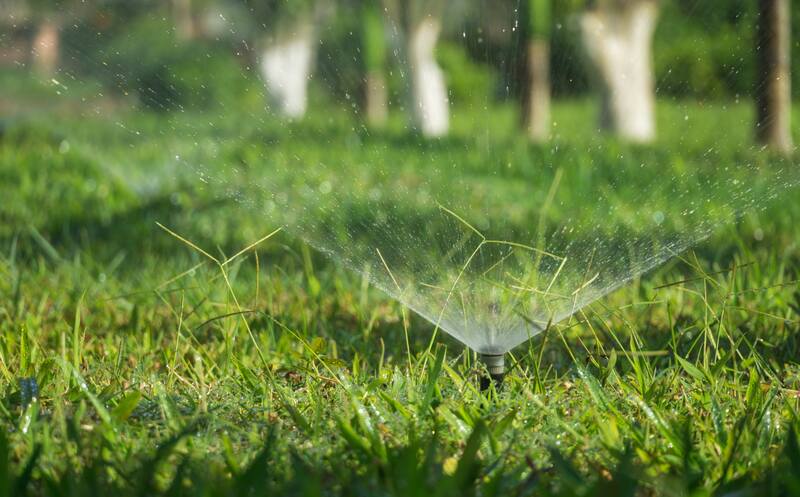
They are also known as rotary nozzles or multi-stream rotation sprinkler heads. This type of sprinkler nozzle spreads 0.3 to 0.7 inches of water per hour, in dense streams that rotate over the lawn. Compared to the fixed fan-shaped water mist (1 to 2 inches per hour) of classic spray heads, rotary nozzles:
- Allow for better percolation
- Reduce evaporation
- Are less affected by wind drift
- Prevent runoff and soil erosion (especially on sloped lawns)
They need to run up to 3 times longer than standard heads to ensure enough water, and they require a higher water pressure of 40 to 45 PSI. Even running longer, rotary nozzles have the potential to reduce water usage by up to 30%. It’s worth talking to a lawn care professional about making this adjustment on your Florida lawn.
8. Harvest Rainwater
With an average rainfall of 52 inches per year, Florida has excellent potential for rainwater harvesting. Collecting stormwater is easy, and during the wet season, it is a brilliant solution to have more water for your lawn, flower beds, trees, and vegetable garden.
There are no rainwater harvesting restrictions in Florida and the practice is highly encouraged by the state with several local municipalities offering:
- Rebate programs (Manatee County, Orlando, City of Melbourne, City of Cocoa, St. Petersburg)
- Specialized workshops at your local UF Extension Office as part of the Florida-Friendly Landscape Program (read our article about the principles of Florida-friendly landscaping)
All you need is a rain barrel, a water tank, or a rain cistern to collect water from the roof and gutters. You can collect about half a gallon of water from each square foot of roof for every inch of rainfall.
9. Choose the Right Type of Grass for Your Florida Lawn
Although highly popular in Florida, St. Augustine grass has a lower drought tolerance than other warm-season grasses. Consider replacing it with more drought-resistant Florida grass types like:
- Bermudagrass
- Zoysiagrass
- Buffalo grass
Pro tips about landscaping your Florida lawn:
- Get rid of narrow grass strips along driveways and pathways. They are harder to irrigate without getting water on impervious surfaces.
- Reduce turfgrass surface (it’s the biggest water consumer) and add some native Florida plants. You’ll only need to water them until they are established and during prolonged droughts.
10. Mow the Grass Taller
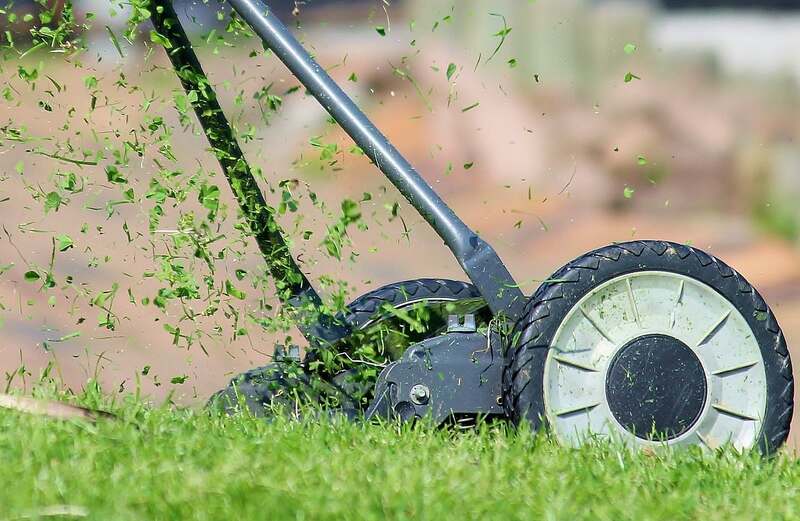
What does mowing have to do with watering? It’s actually pretty simple. Mowing the grass at the proper height promotes deep roots that can easily access the ground’s moisture. This makes the plants more drought-tolerant. As a result, you’ll water the lawn less often no matter the season.
When you mow the grass taller during summer, you also provide more shade for the soil, reducing water evaporation.
11. Aerate and Dethatch the Lawn
Aerate and dethatch the lawn at least once a year to ensure water absorption and percolation. Soil compaction and thatch are two problems that can lead to wasting water. They prevent proper water absorption, leading to:
- Runoff
- High evaporation rates
- The need to irrigate more often
Lawn aeration and dethatching can prevent these issues, helping you save water and improving your lawn’s health. Check out our guides on how to aerate your lawn and how to dethatch for more information.
Pro tips on maintaining good soil drainage in Florida:
- Some Florida grasses, like St. Augustinegrass and Bermudagrass, are more prone to forming thatch and require more frequent dethatching.
- Adding organic matter to amend Florida’s sandy soil can form a tough layer, preventing air, water, and nutrients from saturating the soil deeper. Use a core aerator to break it up.
FAQ
It depends on the soil type and what sprinkler nozzles you use. With spray-heads, you need 15 to 30 minutes to apply half an inch of water. If you’re using rotary nozzles, run them for 45 to 90 minutes. Sandy soils absorb water fast, so you can use sprinkler nozzles with a higher debit than for clay soils.
Florida sandy soils add a little twist to the “water deep and less frequently” rule. Since sandy soil retains only about 1 inch of water in the root zone, don’t try to soak it. Apply ½ to ¾ inches of water per session. Any excess infiltrates below the point where roots can access it. But keep the low frequency and water only when the grass looks wilted.
Generally, once or twice a week. But it’s best to let the grass set the tone. Try to water only when 30 to 50% of the lawn shows signs of drought like folded blades, bluish-grey color, and slower recovery from foot traffic.
Yes. Applying fertilizer makes the grass grow faster, which also makes it thirstier. Applying fertilizer at the wrong time of year can make your grass use too much water. See our optimal lawn fertilization schedule for Florida to make sure you’re fertilizing at the best time of year.
Keep Your Florida Lawn Healthy and Fresh!
We talked about a few practical tips to help you water your Florida lawn correctly each time. With a proper lawn watering schedule, you can be sure your grass will grow constantly. For help keeping it at an attractive height, you can always hire a local LawnStarter lawn care pro for weekly or bi-weekly mowing.
Search here for a lawn care company near you or find a trustworthy lawn care service in your city on our local pages:
- Lawn care services in Jacksonville, FL
- Lawn care services in Miami, FL
- Lawn care services in Tampa, FL
- Lawn care services in Orlando, FL
- Lawn care services in St. Petersburg, FL
LawnStarter’s pros are here to help you maintain your dream lawn, but you have to do your part by maintaining a healthy watering schedule, too!
Main Image Credit: Pexels